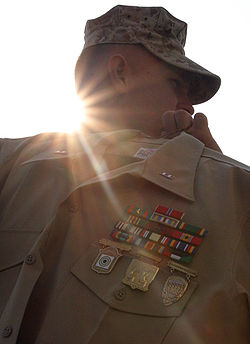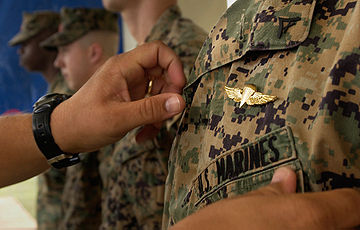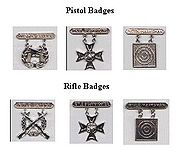
Badges of the United States Marine Corps
Encyclopedia

United States Department of the Navy
The Department of the Navy of the United States of America was established by an Act of Congress on 30 April 1798, to provide a government organizational structure to the United States Navy and, from 1834 onwards, for the United States Marine Corps, and when directed by the President, of the...
to Marines who achieve certain qualifications and accomplishments while serving on both active and reserve duty in the United States Marine Corps
United States Marine Corps
The United States Marine Corps is a branch of the United States Armed Forces responsible for providing power projection from the sea, using the mobility of the United States Navy to deliver combined-arms task forces rapidly. It is one of seven uniformed services of the United States...
.
As described in Chapters 4 and 5 of Marine Corps Uniform Regulations, "badges" are categorized as breast insignia (worn immediately above ribbons/medals), identification badges (usually worn at breast pocket level), and marksmanship badges (worn immediately below ribbons).
For the purpose of this article, the term "badge" shall be used exclusively to describe identification badges and marksmanship badges, and the term "insignia" shall be used for other worn accouterments, according to the language in Marine Corps Uniform Regulations.
The modern day United States Marine Corps currently maintains the following breast insignia and identification badges:
Breast Insignia

Authorized breast insignia are worn on the left breast of all service and dress coats. They may optionally be worn on khaki shirts when the shirt is the outermost garment, utility coats or maternity work uniform coats. Miniature versions exist for evening dress jackets.
When worn alone, it is worn in the same position a single ribbon would be worn. When worn with ribbons, medals, or marksmanship badges, it is positioned 1/8 in above such awards. On combat utility uniform coats with slanted pockets, it is worn above a horizontal line tangent to the highest point of the pocket or "U.S. MARINES" service tape.
No more than two USMC-approved breast insignia shall be worn at any one time. When two insignia are worn they are ordered from top to bottom in the following order with 1/8 in separation in between: diver, EOD, parachutist, aviation. A Marine with more than one insignia within the parachutist, EOD and diver groups may only wear the senior insignia of the group. Marines may wear two insignia from the aviation group.
Aviation Insignia

Officer insignia include the Naval Aviator insignia for pilots and the Naval Flight Officer insignia for non-piloting officers. There is also an astronaut version
Astronaut Badge
The Astronaut Badge is a badge of the United States, awarded to military and civilian pilots who have completed training and performed a successful spaceflight...
of each of these insignia, known as the Naval Astronaut and Naval Astronaut (NFO), respectively.
The Marine Aerial Navigator insignia is issued to enlisted personnel qualified to act as navigator
Navigator
A navigator is the person on board a ship or aircraft responsible for its navigation. The navigator's primary responsibility is to be aware of ship or aircraft position at all times. Responsibilities include planning the journey, advising the Captain or aircraft Commander of estimated timing to...
s aboard Marine aircraft; the Naval Aviation Observer insignia is issued to flight support personnel; and the Aircrew insignia is issued to enlisted personnel designated to operate equipment aboard airborne aircraft.
Parachutist Insignia

The Parachutist Insignia, also known as "lead sleds", is awarded to personnel upon successful completion of the Basic Airborne Course at the Army Airborne School
United States Army Airborne School
The United States Army Airborne School — widely known as Jump School — conducts the basic paratrooper training for the United States armed forces. It is operated by the 1st Battalion , 507th Infantry, United States Army Infantry School, Fort Benning, Georgia...
. The basic insignia is issued for completion of basic parachutist training, five qualifying jumps. The Navy and Marine Corps Parachutist breast insignia, also known as "gold wings" are issued after five additional qualifying jumps.
Explosive Ordnance Disposal Insignia

The Explosive Ordnance Disposal (EOD) Breast Insignia, also known as the "Crab", is awarded to personnel who have successfully completed training at the Naval School Explosive Ordnance Disposal (NAVSCOLEOD), Eglin Air Force Base
Eglin Air Force Base
Eglin Air Force Base is a United States Air Force base located approximately 3 miles southwest of Valparaiso, Florida in Okaloosa County....
, Florida. Personnel are trained to deal with the render-safe
Render safe procedure
The render safe procedure is the portion of the explosive ordnance disposal procedures involving the application of special explosive ordnance disposal procedures, methods and tools to provide the interruption of functions or separation of essential components of unexploded ordnance to prevent an...
and disposal
Bomb disposal
Bomb disposal is the process by which hazardous explosive devices are rendered safe. Bomb disposal is an all encompassing term to describe the separate, but interrelated functions in the following fields:*Military:...
of conventional and unconventional munitions ranging from unserviceable small arms
Small arms
Small arms is a term of art used by armed forces to denote infantry weapons an individual soldier may carry. The description is usually limited to revolvers, pistols, submachine guns, carbines, assault rifles, battle rifles, multiple barrel firearms, sniper rifles, squad automatic weapons, light...
ammunition, improvised explosive device
Improvised explosive device
An improvised explosive device , also known as a roadside bomb, is a homemade bomb constructed and deployed in ways other than in conventional military action...
s (IEDs), to chemical
Chemical warfare
Chemical warfare involves using the toxic properties of chemical substances as weapons. This type of warfare is distinct from Nuclear warfare and Biological warfare, which together make up NBC, the military acronym for Nuclear, Biological, and Chemical...
/biological
Biological warfare
Biological warfare is the use of biological toxins or infectious agents such as bacteria, viruses, and fungi with intent to kill or incapacitate humans, animals or plants as an act of war...
and nuclear
Nuclear weapon
A nuclear weapon is an explosive device that derives its destructive force from nuclear reactions, either fission or a combination of fission and fusion. Both reactions release vast quantities of energy from relatively small amounts of matter. The first fission bomb test released the same amount...
munitions.
Diver Insignia
Diver Insignia are issued to personnel who are qualified divers and is given in several degrees. The first degree of diver insignia is SCUBAScuba diving
Scuba diving is a form of underwater diving in which a diver uses a scuba set to breathe underwater....
Diver. The remaining insignia are awarded for deep sea dive qualifications and are issued in the degrees of Second Class, First Class, Master Diver, and Diving Medical Technician for medical personnel who have qualified as both divers and medical response personnel to medical emergencies underwater.
Combatant diver insignia is issued to graduates of the Combatant Diver Course
United States Marine Corps Combatant Diver Course
The USMC Combatant Diver Course is taught at the Navy Diving and Salvage Training Center, Naval Support Activity Panama City, Panama City, Florida. Both of the Marine Air-Ground Task Force reconnaissance assets, FMF Recon and MarDiv Recon, widely use combatant diving...
, who are typically in the recon community
United States Marine Air-Ground Task Force Reconnaissance
The United States Marine Corps have many reconnaissance elements that are valuable to a Marine Air-Ground Task Force by providing the force and component commanders [i.e. Marine Expeditionary Force or Landing Force commanders] with maneuver space and reaction time, and prevent enemy forces and...
. This badge features a Dräger
Dräger
The Drägerwerk AG is a German company based in Lübeck which makes breathing and protection equipment, gas detection and analysis systems, and noninvasive patient monitoring technologies. Customers include hospitals, fire departments and diving companies....
LAR-V rebreather
Rebreather
A rebreather is a type of breathing set that provides a breathing gas containing oxygen and recycled exhaled gas. This recycling reduces the volume of breathing gas used, making a rebreather lighter and more compact than an open-circuit breathing set for the same duration in environments where...
and low-profile diving mask
Diving mask
A diving mask is an item of diving equipment that allows scuba divers, free-divers, and snorkelers to see clearly underwater. When the human eye is in direct contact with water as opposed to air, its normal environment, light entering the eye is refracted by a different angle and the eye is unable...
.
Marksmanship Badges
Marine Corps marksmanship qualification badges are suspended beneath a bar reading the type of weapon and qualification received. The badge is also different in appearance, depending on which weapon qualification has been obtained. For a marksmanship qualification badge to be obtained, a service member must obtain a passing score and will receive a qualification level depending on the score obtained. Once a qualification has been obtained, and the marksmanship badge issued, the badge may be worn for the remainder of a military career, or until a different level of qualification (higher or lower) is achieved.In addition to the standard marksmanship badges, the Marine Corps has numerous marksmanship competition badges that are authorized for wear on the Marine Corps uniform. These badges are awarded alongside trophies that are present to the top performing Marines at Marine Corps sponsored marksmanship competitions. These badges are warn alongside the standard Marine Corps marksmanship qualification badges.
 |
See also
- Uniforms of the United States Marine CorpsUniforms of the United States Marine CorpsThe Uniforms of the United States Marine Corps serve to distinguish Marines from members of other services. Among current uniforms in the United States Armed Forces, the Marines' uniforms have been in service the longest...
- Military badges of the United StatesMilitary badges of the United StatesMilitary badges of the United States are awards authorized by the United States armed forces that signify rating, qualification, or accomplishment in several career fields, and also serve as identification devices for personnel occupying certain assignments. Personal recognition is granted to...
- Identification badges of the United States military
- Obsolete badges of the United States militaryObsolete badges of the United States militaryObsolete badges of the United States military are a number of U.S. military insignia which were issued in the early 20th century leading up to and including badges issued during the Second World War. Such badges were eventually phased out of the United States armed forces in favor of the modern...

